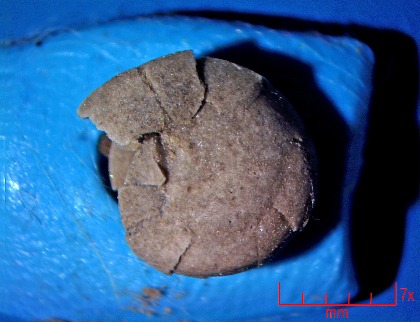|
Lower Permian Nautiloids
are found in both the Fort Apache Limestone, and overlying Kaibab
formation. Far more commonly found in the Kaibab, they range
in size from quarter sized to 12 inch monsters. But in the Fort
Apache, we have found so far only two nautiloids in our years
of searching. Fortunately, they are both different morphologically
and offer an interesting cross section of cephalopod life in
the Fort Apache Sea. It is notable that Winters, in his monumental
GSA monograph memoir 89 found only the orthocone type and identified
it tentatively as Psudorothoceras knoxense.

|
Aperture
comparison. The differences in similar mollusks can be ascertained
by comparing the shapes of the openings. (Aperture) On the left,
Bellerophon - a monoplacophoran has a decidedly triangular opening.
Center are a gastropod called Knightites sp. which looks very
much like a small Bellerophontid, but is a gastropod. And on
the right, the cephalopods have a much larger and oval opening,
such as the small pea sized specimen we found below. |

|
This
little cutie was found mixed in with our first picks for gastropods
out of the acid fines. This was the only one like this, and you
can clearly see the septa evenly spaced along its periphery.
The center is filled in with sediment thus appears as a mound
here hiding the details of the inner whorls. |

|
The
back side is obscured by an urchin spine that was attached to
it, but you can still see some of the septa clearly. |

|
View
of the aperture, a bit crushed showing the inner whorls tucking
into the opening oh-so-nautiloid style! |

|
Orthocone
nautiloid section found at site 2 as well. This is an orthoceras
type cf. Psudorothoceras knoxense. The septa can be seen inside
the eroded openings in the outer conch. |

|
Fortunately,
one end has a great view of one of the concave septa. This then
would have been the side that the animal lived on in the conch.
It is difficult to say how long the original conch was, perhaps
6 inches or so. |
|

